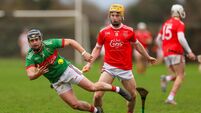To reach the top, just go with the flow
You’ve probably said it. You’ve certainly noticed it. A sportsperson says it in passing after a great performance: I was in the zone.
You clock it and you move on. Good for them.
But what if you could reach that level of excellence on a regular basis? Steven Kotler believes you can. He says achieving flow, operating at that maximum level, needn’t be something that happens once or twice in a sporting career: it can happen all the time.
Kotler started off as a novelist, and fell into magazine journalism as a way to pay the bills in the early 90s. He could ski, snowboard and surf, and given action sports were a hot topic, there was plenty of work for him. Skiing was his forte, and at Chamonix he had the epiphany that led, ultimately, to this book.
“Some of the early extreme skiers were there, and in the middle of a 50-degree slope, I was hanging on for my life, and ground to a halt,” he says.
“One of the world’s best extreme skiers was right behind me when that happened, and instead of smashing into me and killing us both, he jumped to my right, sailed off a 30-foot cliff, landed on a tiny patch of snow and got back onto the slope and just kept going as if nothing had happened.
“It was one of the most insane things I’d ever seen. It just didn’t look possible. It defied the laws of physics, but over that weekend I saw more and more events like that, a step beyond anything I’d seen in skiing before.
“I remember thinking then that that was the upper level of progression, but it was just the beginning.”
Kotler points to an “almost exponential” growth in ultimate human performance in the past 25 years.
“That growth has been when life and limb is on the line, though evolutionary theory tells us that should be the slowest growth category of all.
“At no point in history should progress quintuple in a decade, yet that’s what we’re seeing here in surfing in particular.
“Here’s a 1000-year-old sport and from 400AD to 1996, the highest wave anyone surfed was 25 feet — above that, scientists and surfers didn’t think you could survive. Now people are regularly surfing waves 100 feet high.”
Kotler isn’t about to drift into a reverie on the spirituality of surfing, however.
“I work on the neurobiology of flow states. When we talk about flow, we mean an optimal state of consciousness when we feel our best and perform our best.
“That’s a technical definition, but more generally, people have a passing acquaintance with flow. If you’ve ever had a work conversation so engrossing that everything else falls away, for instance, you’ve tasted the experience.
“In flow, attention becomes so focused on the task at hand, that action and awareness start to merge, your sense of self-consciousness starts to disappear and time dilates. It slows down, as happens sometimes to people in a car crash, or it speeds up and five hours passes like five minutes. All aspects of performance go through the roof.”
Kotler understands the impulse to link flow with spirituality, but prefers to stress the hard science behind the soulfulness.
“In deep flow there can be a sense of oneness with everything, which is why people call flow spiritual, Huxley’s ‘cosmic unity’.
“But what’s really interesting, and what I focus on, is that we’ve started to map the neurobiology of flow, what happens in the brain during flow, and because of that, we understand there’s biology behind the sense that time is passing slowly, the sense of oneness and so on.
“Until roughly 1990, flow was a black box, a subjective experience that you couldn’t apply hard metrics to. Now we have good EEG and MRI measurements, however, and good blood tests and smart technology like the Nike FuelBand. So not only do we understand the psychology, we’re beginning to understand the physiology.”
The significant development, says Kotler, is that there is now progress on how to reliably reproduce the experience: “We know there are triggers for flow and we’re figuring out that, for instance, action/adventure sports people started harnessing flow more frequently than anyone else.
“That doesn’t mean flow doesn’t happen across the board. McKinsey, the business researchers, have done a 10-year study showing top executives are five times more productive when in flow; in the US military, snipers learn 200% to 500% faster when in flow.
“But action/adventure sports people became the best at achieving flow out of intuitive necessity. They had to get into flow and up their performance or end up in hospital, or dead.
“A lot of people still ended up in hospital, of course, myself included.”
That’s fine, of course, knowing there’s a state of transcendent focus which will help you succeed.
How do you reach that state without, as Kotler says, ending up in hospital?
“The best news is that we now know flow has 17 triggers, and every single one of them can be applied anywhere in life. You don’t have to be atop athlete or top performer to achieve flow.
“It’s ubiquitous. It shows up anywhere so long as certain initial conditions are met, and we can apply those triggers anywhere.
“There’s a shared version of flow, a group flow scenario. Watch live music, you see a good band in action and that’s flow. If you’ve ever taken part in a great brainstorming session, that’s group flow in action.”
For details of what those triggers do, Kotler has hard evidence.
“Thanks to the work of Keith Sawyer of Washington University in St Louis, who in 15 years mapped 10 social triggers for flow, we know more about those triggers.
“Some of those are fairly obvious — flow follows focus, so what those triggers do is they help drive focus into the here and now.
“What they really help to do is trigger neuro-chemical releases; for instance, creating group flow can be helped by applying the first rule of improv: always say ‘yes’.”
How so? “If we’re performing improv and I say ‘there’s a blue elephant in the bathroom’, if you say ‘no’ that kills it. But if you say, ‘yes, he’s using your deodorant’, then it goes somewhere.
“Always say yes doesn’t mean ‘don’t be critical’, because you have to be critical but you must drive the conversation forward, and make it additive, and that makes everyone a participant, making them pay attention — and that drives focus.”
Find the triggers. Find your flow.
* The Rise of Superman: Decoding the Science of Ultimate HumanPerformance, by Steven Kotler (New Harvest, €13).













